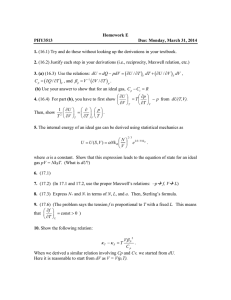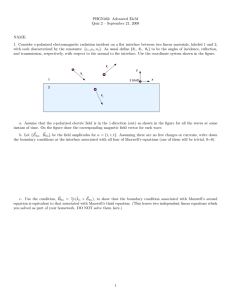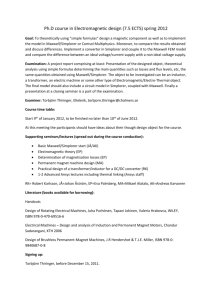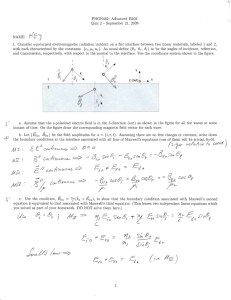View or Dr. Yaghjian`s slides here. - EECS
advertisement
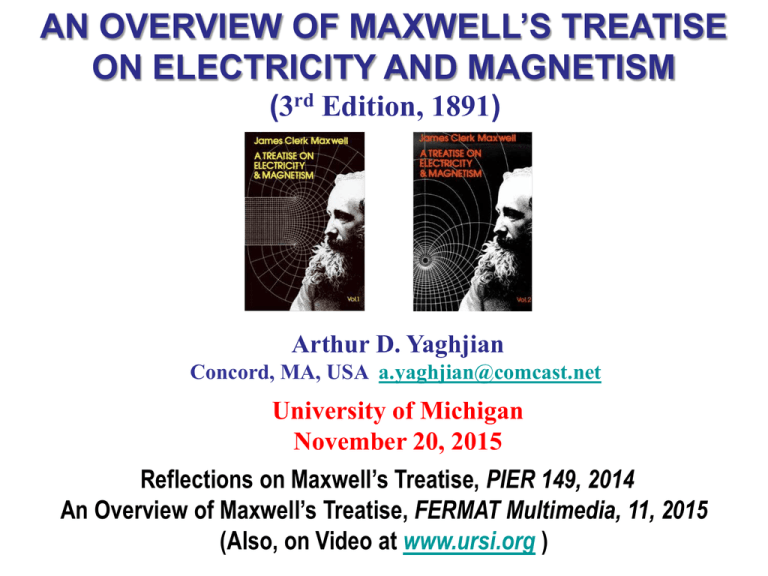
AN OVERVIEW OF MAXWELL’S TREATISE ON ELECTRICITY AND MAGNETISM (3rd Edition, 1891) Arthur D. Yaghjian Concord, MA, USA a.yaghjian@comcast.net University of Michigan November 20, 2015 Reflections on Maxwell’s Treatise, PIER 149, 2014 An Overview of Maxwell’s Treatise, FERMAT Multimedia, 11, 2015 (Also, on Video at www.ursi.org ) • • • • • • • • • What free-space fields did Maxwell take as primary: E and H or E and B? How did Maxwell obtain fields and eqs. in source regions? Did he begin with the integral or the differential equations? Did he use vectors and vector eqs. or just scalar eqs.? Did he express his eqs. in the same way we do today? Did he average microscopic fields to get macroscopic fields. Did he write Faraday’s law explicitly? Did he derive the Lorentz force in his treatise? Did he always use the Coulomb gauge ( A = 0)? How did he determine the speed of light? .D • SOME QUESTIONS PHOTOS OF MAXWELL Student at Cambridge (about 20) Writing Treatise 38 Professor at King’s College (Wrote Dynamical Theory … paper) (about 30) Later Years (Died at 48) SYNOPSIS OF MAXWELL’S LIFE • • • • • • • • • • Born of Scottish parents in Edinburgh (1831). Extremely precocious child who wanted to know how everything “doos”. Mother died when he was 8 years old. Father gave him best education available in humanities, sciences, and mathematics. Stuttered as a child and made fun of by other students. Wrote poetry as a child and for the rest of his life. He grew to a height of 64.5 inches (165 cm). At 14 years old he published a paper on oval curves in the Royal Society of Edinburgh. Studied at Edinburgh and then Cambridge University. “My plan is to let nothing be left willfully unexamined”. SYNOPSIS OF MAXWELL’S LIFE • • • • • • • • • A genius with a “superabundance” of energy. At 25 became a Professor at Marischal College. Both praised and criticized for his inspired teaching. Married Katherine Dewar, the principal’s daughter at Marischal (no children). Appointed chair at King’s college, London in 1860. Left in 1865 to write his Treatise, then became the first Cavendish Professor at Cambridge (1871-1879). Knew Greek, Latin, French, and German and rapidly learned Italian to talk with Prof. Matteucci in Italy. Devout Christian who believed that his scientific work was his Christian vocation. Died at 48 of stomach cancer in 1879, the year Einstein, the next extraordinary physicist, was born. • • • • TRIBUTES TO MAXWELL The special theory of relativity owes its origins to Maxwell’s equations of the electromagnetic field. … This change in the conception of reality is the most profound and the most fruitful that physics has experienced since the time of Newton. Albert Einstein (“I stand on Maxwell’s shoulders.”) All these theories [Einstein’s theories of relativity, quantum mechanics, Yang-Mills theory, the Standard Model of particle physics] are based on the concept of dynamical fields Are they talking introduced by Maxwell in 1865. about me? Freeman Dyson From a long view of the history of mankind - seen from, say, ten thousand years from now – there can be little doubt that the most significant event of the 19th century will be judged as Maxwell’s discovery of the laws of electrodynamics. Richard Feynman The leading note of Maxwell’s character is a grand simplicity. Lewis Campbell (Life-long friend, minister, and biographer) INTENT OF THIS TALK This talk is an overview of what Maxwell did and how he did it in the 3rd edition of his Treatise (1891) and not in his earlier publiccations. If additions by the editors, W.D. Niven and J.J. Thomson, are ignored, the 3rd edition is the same as the 1st edition with the first nine chapters on electrostatics revised by Maxwell before he died in 1879. INTENT OF THIS TALK The talk is not an historical account of the development of electromagnetics by Maxwell and others. There are several good books on this subject. COMMENTS ON MAXWELL’S TREATISE • Maxwell writes very logically, simply, and clearly. • The Treatise is not an “easy read” because of: 1) Nineteenth century notation and terminology 2) Extensive cross referencing in the 866 “articles” (sections) of the Treatise 3) Nineteenth century physical explanations William Hopkins, his tutor at Cambridge said, … he is unquestionably the most extraordinary man I have met with, in the whole range of my experience; it appears impossible for Maxwell to think incorrectly on physical subjects … Quit whining. MOLECULAR VORTICES MODEL In his Treatise Maxwell discards his “molecular vortices” model, mentioning it only briefly and saying it was just one of an infinite number of possible “demonstrations that a mechanism may be imagined capable of producing a connexion mechanically equivalent to the actual connexion of the parts of the electromagnetic field”. Forget mechanical models. MAXWELL’S MOLECULAR VORTICES (Free space with permeability m0 = 1) MAXWELL’S MOLECULAR VORTICES (Incompressible fluid with mass density r0 = 1) Circulating (cancelling) vorticity sources V Line vorticity source in fluid V W=ÑxV (fluid vorticity) (fluid momentum) THEORY OF MOLECULAR VORTICES vorticity = curl of momentum magnetic field = curl of vector potential force = time change of momentum + grad pressure - electric field = time change of vector potential + grad scalar potential Vorticity equation Faraday’s law Wheels within Wheels THEORY OF MOLECULAR VORTICES Ampere’s law does not follow from the vortex model All analogies limp. QUATERNIONS Maxwell uses only the “language” of Quaternions (scalars, vectors, nabla). “We shall not, however, expressly introduce Quaternion notation. … In this treatise we have endeavored to avoid any process demanding of the reader a knowledge of the Calculus of Quaternions”. I like vectors. NOTATION IN TREATISE Maxwell uses present-day notation for vectors (with German letters) and Hamilton’s notation for the gradient ( ), divergence (S. ), and curl (V. ). Maxwell used “d” rather than “ ”, which was not in wide use during his lifetime. Omits V. if divergence is zero Divergence Curl Time Derivative Maxwell introduced the term “curl” and used the term “convergence” instead of “divergence” because of the minus sign. Clever guy that Hamilton. Treatise Today Vector Potential Magnetic Induction (induces electromotive force) Magnetic Field Magnetization Velocity of a point Electric Field Maxwell defines “electromotive force” as the force (or line integral of) on a moving unit charge. Electromotive Force Lorentz force Electric Displacement Conduction Current Total Electric Current Mechanical Force Electric and Magnetic Charge Density Electric and Magnetic Potential Electric Conductivity Permeability, Permittivity Lots of variables! DYADICS AND DISPERSION Maxwell says that s, m, and e are generally functions of position and can also be dyadics (“linear vector operators”). All other variables can be functions of space and time (r, t). He also says that some media can be temporally dispersive, but he will confine his attention to nondispersive constitutive relations, for example, D = eE . I did not consider spatial dispersion. FIELDS DEFINED IN FREE SPACE Maxwell defines the electric (magnetic) field in free space as the force on a stationary unit electric (magnetic) positively charged particle “place there without disturbing the actual distribution”. In modern textbooks (we shall use SI units) Note H, not B From Faraday’s law, he derives the force on a moving positive unit electric charge in magnetic induction B as F = v x B , but he does not use this result to define B . I introduced magnetic monopoles and used Electromagnetic Units (m0 = 1) with unrationalized equations (4p in Ampere’s law). Electrostatic Units (e0 = 1) are okay too. MAGNETIC DIPOLES Maxwell forms magnetic dipoles from two opposite magnetic charges, even though he says he tends to agree with Ampere that magnets are formed by an “immense number of magnetic molecules” containing circulating electric currents. He explains “This method of representing the action of a magnet as due to a distribution of ‘magnetic matter’ [magnetic charge] is very convenient, but we must always remember that it is only an artificial method of representing the action of a system of polarized particles.” Magnetic charge is nice but probably does not exist in nature. AMPERIAN MAGNETIC DIPOLES Primary current producing m0 that aligns with B Induced current producing m that opposes B Ferromagnetism Diamagnetism Maxwell explained ferromagnetism by the alignment of “primary” pre-existing currents on PEC wire loops. He explained diamagnetism by induced current on PEC wire loops with zero initial current. Who says diamagnetism can’t be explained classically? ELECTRIC DIPOLES Maxwell does not introduce electric dipoles anywhere in his Treatise. He speaks of polarization in general but he does not introduce P, only D = eE. (Larmor introduced P and D = e0E+P in 1895.) Maxwell did P because he assumed . not introduce . that Jc + D (not Jc + P) was the equivalent current and . D (not - . P) was. the equivalent charge. He didn’t begin with e0E in Ampere’s law. D Who needs P when you got D? D CHARGE, CURRENT, POLARIZATION Although Maxwell defines the fields of point charges and dipoles, he treats charge, current, and polarization densities as continua. He does not average microscopic fields to get macroscopic fields. He says that electrolysis can be explained by assuming “one molecule of electricity [discrete charge],” though this is “out of harmony with the rest of this treatise”. Maxwell does not anticipate the discovery of the electron. J.J. Thomson discovered the electron in 1897, 18 years after I died. FIELDS IN SOURCE REGIONS Maxwell defines fields within source densities of continuous charge, current, and polarization as mathematical fields derived from potentials that are “found by the same mathematical process, whether the given [field] point is outside the … [source region] or within it”. I defined fields in source regions mathematically by continuum equations. FIELDS IN SOURCE REGIONS (Charge and Polarization) From Coulomb’s law, Maxwell finds and for r and S not in the charge density. He then lets the integrals hold in the charge density as well so as to mathematically define E everywhere and obtain . He says that from Faraday’s measurements of capacitors in dielectrics, where D is given by ( is measured) which he calls “electric displacement”. Good Ole Faraday! FIELDS IN SOURCE REGIONS (Current) Similarly, Maxwell lets the curve C in Ampere’s Law Note H, not B lie in the current region to get .He then says the divergence of this last equation is compatible with the continuity equation and if so let !!! Note that H not B is the primary magnetic field. No displacement current, no light. FIELDS IN SOURCE REGIONS (Magnetization) Maxwell assumes “Coulomb’s law” for static magnetic charge qm to get the potential y outside a magnetic dipole of moment m, which he replaces with M dV and integrates by parts, letting this potential hold within the magnetization, to obtain ( which he uses to determine Cavity Fields. Again, note that H not B is the primary magnetic field. Coulomb We can measure fields in cavities. ) CAVITY FIELDS (Magnetization) “To determine by experiment the magnetic force at a point within the magnet we must begin by removing part of the magnetized substance, so as to form a cavity within which we are to place the magnetic pole [charge]. … It is manifest that when the form and position of the cavity is specified, the point within it at which the magnetic pole is placed must be regarded as no longer within the substance of the magnet, and therefore the ordinary methods of determining the force become at once applicable.” I repeat, we can measure fields in cavities. CAVITY FIELDS (Magnetization) H Thin Cylinder M B / m0 Thin Disk “Hence, when the cavity is a very narrow cylinder with its axis parallel to the direction of magnetization [M], the magnetic force within the cavity is not affected by the surface distribution on the ends of the cylinder, and the components of this force are simply [H]. … We shall define the force within a hollow disk, whose plane sides are normal to the direction of magnetization, as the magnetic induction [B] within the magnet. … The three vectors, the magnetization M, the magnetic force [field] H, and the magnetic induction B, are connected by the vector equation B = m0 (H + M) .” Later, Maxwell shows that B induces an electromotive force. CAVITY FIELDS (Electric Polarization) E Thin Cylinder P D/e0 Thin Disk Maxwell does not introduce electric polarization P, or D = e0 E + P because he looks at D as primary (producing the equivalent current and charge), and considers only linear dielectric material with D = eE. Moreover, he assumed electric polarization existed in free space (the ether) and thus was uncertain as to how it arose in either the ether or materials. I didn’t know exactly how the ether or matter got polarized. EQUATIONS FOR MAGNETIC INDUCTION (B) Maxwell notes that the following equation for the H field with is like the electrostatic equation with and replacing the volume and surface electric charge, respectively, and therefore or since B = m0(H + M) and thus The Coulomb gauge holds implicitly in magnetostatics. FARADAY’S EXPERIMENTS “It is mainly with the hope of making these ideas [Faraday’s] the basis of a mathematical method that I have undertaken this treatise.” Maxwell concludes from Faraday’s experiments that, “The total electromotive force [ E ] acting round a circuit at any instant is measured by the rate of decrease … of the surface integral [ -dp/dt ] of magnetic induction extended over any surface bounded by the circuit”. Since for a moving circuit he finds I didn’t write one equation. Maxwell does not yet know what the force Ev is on the charge in a moving circuit! Hello, old friend. FARADAY’S EXPERIMENTS Although Maxwell does not yet know what the force Ev is on the charge in a moving circuit, he does know that Ev = E for a stationary circuit and thus from Stoke’s theorem, he finds Hello, old friend. “The electromotive force at a point has already been defined in Art. 68. It is also called the resultant electrical force, being the force which would be experienced by a unit of positive electricity placed at that point.” Maxwell further justifies this field approach to electrodynamics with Lagrange-Hamilton dynamics. Maxwell derives the “Lorentz force” on a unit moving electric charge In one of the tours de force of his Treatise, Maxwell evaluates Faraday’s law for moving circuits, effectively deriving the Helmholtz transport theorem to get the force on a positive electric charge moving with a circuit at velocity v: or since he has shown that F = q(E + v x B) is relativistically covariant. You say that’s the Lorentz force? “The electromotive force at a point has already been defined in Art. 68. It is also called the resultant electrical force, being the force which would be experienced by a unit of positive electricity [charge] placed at that point. We have now obtained the most general value of this quantity in the case of a body moving in a magnetic field due to a variable electric system [that is, in a time varying B].” MAXWELL’S DERIVATION OF JXB FORCE Maxwell never wrote J = rv ! ^ dm = IndA I B dc df = I dc x B (F = J x B) I He found this force by determining the change in I energy of the current loop by displacing a differential element dc of the current loop. I He determined the energy of the current loop by replacing it with a thin shell of magnetic dipoles normal to the surface spanning the current loop. Since solenoidal conduction current is equivalent to magnetic shells, he concluded that the B field would not change the distribution of existing current in a conductor (no Hall effect). MAXWELL’S SUMMARY OF EQUATIONS Maxwell gives an elegant proof that Ñ.A can be chosen 0 if A vanishes at infinity. Four Main Equations Three Definitions (v/c)2 <<1 If curl of H is zero How sweet it is! Three Constitutive Relations Maxwell’s “On Physical Lines of Force” Paper (1861) Maxwell has the four equations that we refer to as “Maxwell’s equations” in this 1861 paper in the scalar form corresponding to I didn’t realize that these equations held in all inertial reference frames! He even finds the Lorentz force but he does not introduce magnetization M or magnetic induction B in his 1861 paper! MECHANICAL FORCE DENSITY AND STRESS Matter with charge, current, and polarization No one is perfect. T Maxwell Stress Dyadic (valid for dynamics as well as statics) Maxwell invokes this stress dyadic to find the radiation pressure in a plane wave! STATIC ENERGY OF FORMATION Matter with charge, current, and polarization Maxwell assumes that this result holds also if electric and magnetic polarization are present --- a correct assumption if D and B are linearly related to E and H, respectively. He uses this result for time-domain fields but does not derive Poynting’s theorem. Picky, picky! LET THERE BE LIGHT In a linear medium with B=mH, D=eE, and “periodic disturbances” He does not assume initially that . A is 0 because A does not vanish at infinity. By taking the divergence of this equation, Maxwell proves (for periodic disturbances) that both ∂f / ∂t and Ñ×A equal zero to obtain D so that !!! Eureka! LET THERE BE LIGHT I needed only an electrometer (forcereading capacitor), a galvanometer, two coils, and a resistor to measure the speed of light. “On the theory that light is an electromagnetic disturbance, propagated in the same medium through which other electromagnetic actions are transmitted, must be the velocity of light, a quantity the value of which has been estimated by several methods”. Measured Fizeau 314,000,000 Parallax 308,000,000 Foucault 298,360,000 (me)-1/2 Weber 310,740,000 Maxwell 288,000,000 Thomson 282,000,000 ESSENCE OF MAXWELL’S EXPERIMENT TO MEASURE THE SPEED OF LIGHT AC Adjust the distance D so that FC + FL = 0 Then from ME’s, we find I V D R where r0 is the mean radius of the coils, Lg is the geometric inductance factor, and a is the time constant of the RL circuit; Two coils just above and below the this time constant is measurable. plates of a capacitor, which is in parallel with the resistor and coils Who says theoreticians can’t do experiments. MAXWELL’S STANDARD UNITS OF LENGTH, TIME, AND MASS BASED ON LIGHT • • • Length and Time: “A more universal unit of time might be found by taking the periodic time of vibration of the particular kind of light whose wavelength is the unit of length.” Mass: “Deduce the unit of mass in this way [from Newton’s 2nd law of motion] from those of length and time already defined [above]; or … [from] the mass of a single molecule of a standard substance.” 4th unit: Maxwell noted that dimensions of electromagnetic quantities become independent of units if charge is taken as a 4th independent unit. Giorgi’s work later led to the Ampere as the 4th standard unit. Nonetheless, the unit Ampere fixes the value of m 0 in ME’s. Giovanni Giorgi did a good thing. SEARCH FOR THE AETHER (Last Sentence of Maxwell’s Treatise) “… if we admit this medium [aether] as an hypothesis, I think it ought to occupy a prominent place in our investigations, and that we ought to endeavour to construct a mental representation of all the details of its action, and this has been my constant aim in this treatise.” I thought the transmission of energy required a medium. • • • • • • • • • • SUMMARY Gives a mathematical theory for the experimental results of Coulomb, Ampere, Faraday, et al. Avoids mechanical models in his Treatise and uses Faraday’s idea of fields to unify electric and magnetic forces. Uses vectors, divergence, and curl like today. Treats charge, current, polarization as continua. Does not anticipate the discovery of the electron. Does not introduce electric polarization P because he . considers D as the total polarization current. Does not average micro fields to get macro fields. The integral forms of his equations are foremost. Defines fields mathematically by applying the freespace integrals inside source regions. Uses magnetic charge and thus H (not B) as the primary magnetic field vector. Quit bragging. • • • • • • • • SUMMARY (Cont’d) Relates cavity fields to mathematical H & B fields but does not do this for E & D fields. Emphasizes Faraday’s Law but not in his summary of equations in Article 619. Finds the “Lorentz force” on moving charge, and nonrelativistic fields in moving media. Vector and scalar potentials seem as real to Maxwell as the electromagnetic fields. Derives the correct static energy density in linear media and the correct stress tensor. Gets incorrect expression for the force density in polarized media because he thinks D rather P produces equivalent charge and current. Says B force does not change the path of conduction current; thus Hall effect not foreseen. Encourages search for evidence of an aether. MAXWELL’S LAST POEM ……... Till in the twilight of the gods, When earth and sun are frozen clods, When, all its energy degraded, Matter to aether shall have faded; We, that is, all the work we’ve done, As waves in aether shall for ever run In ever widening spheres through heavens beyond the sun. ………

